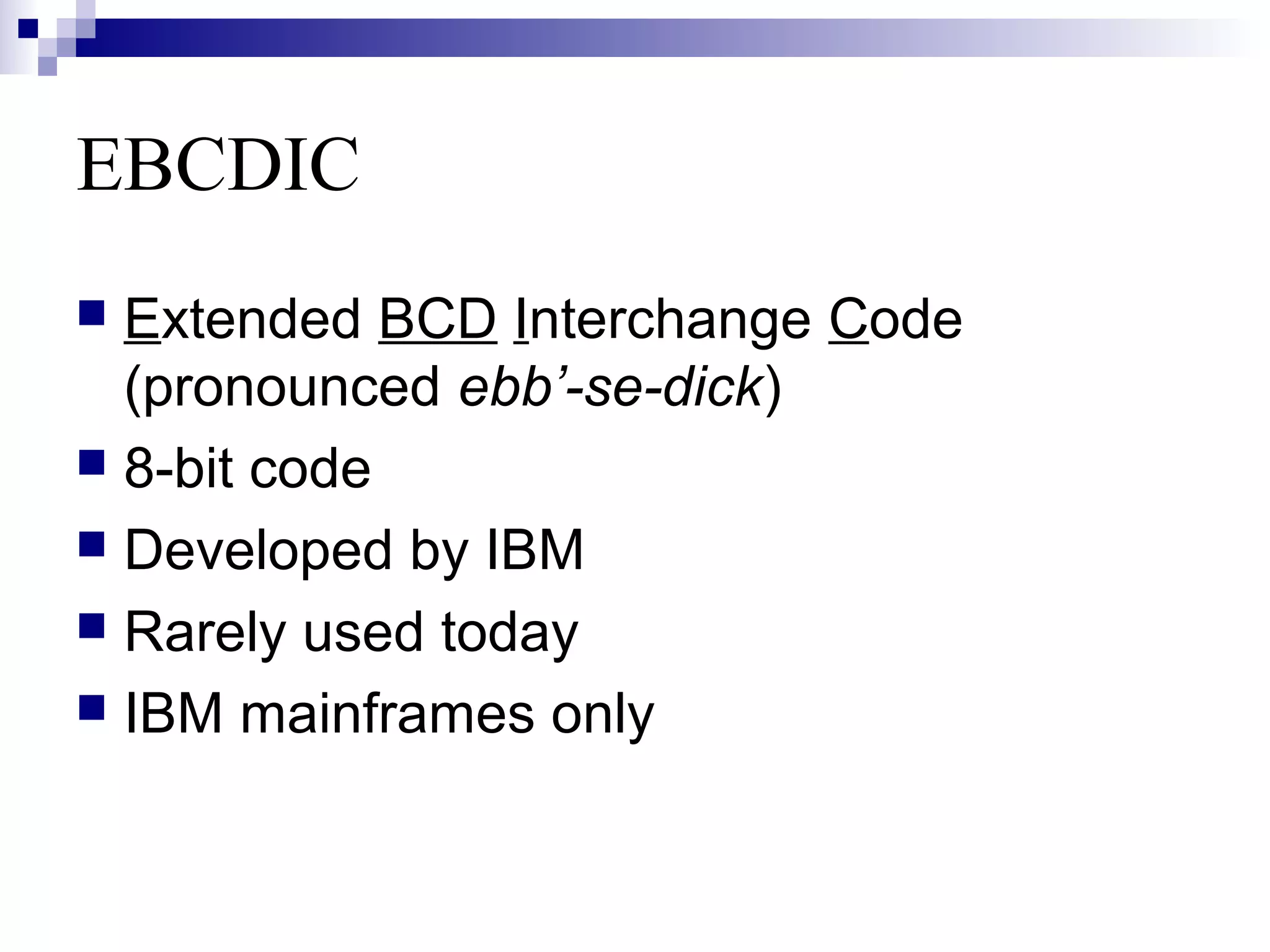The document discusses how computers represent and encode data and characters. It describes:
- Bits and bytes as the basic units of digital information
- Character codes like ASCII and EBCDIC that represent characters as numeric codes to allow computers to process text
- How ASCII in particular assigns a unique 8-bit binary number to each letter, number, and symbol
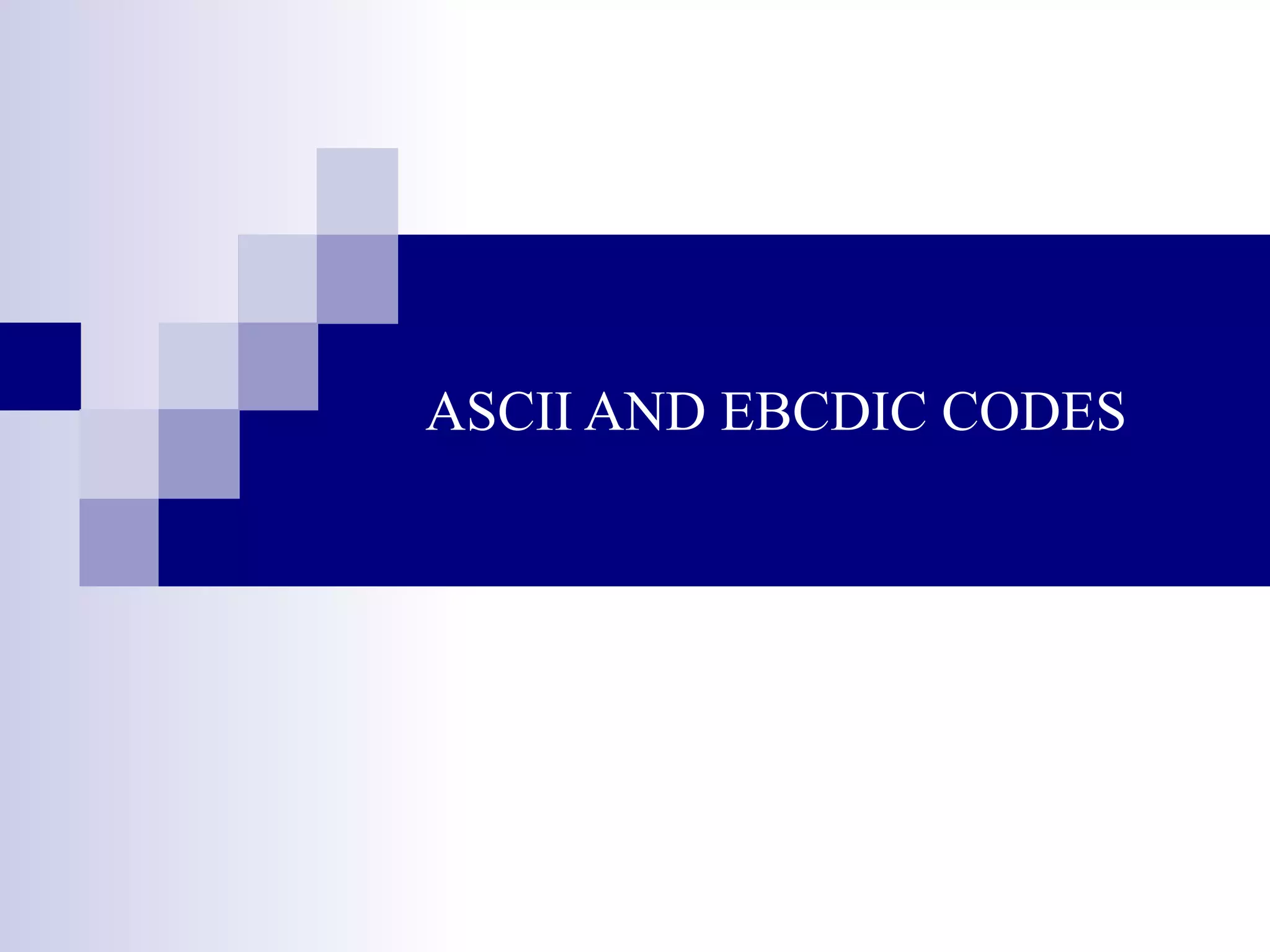

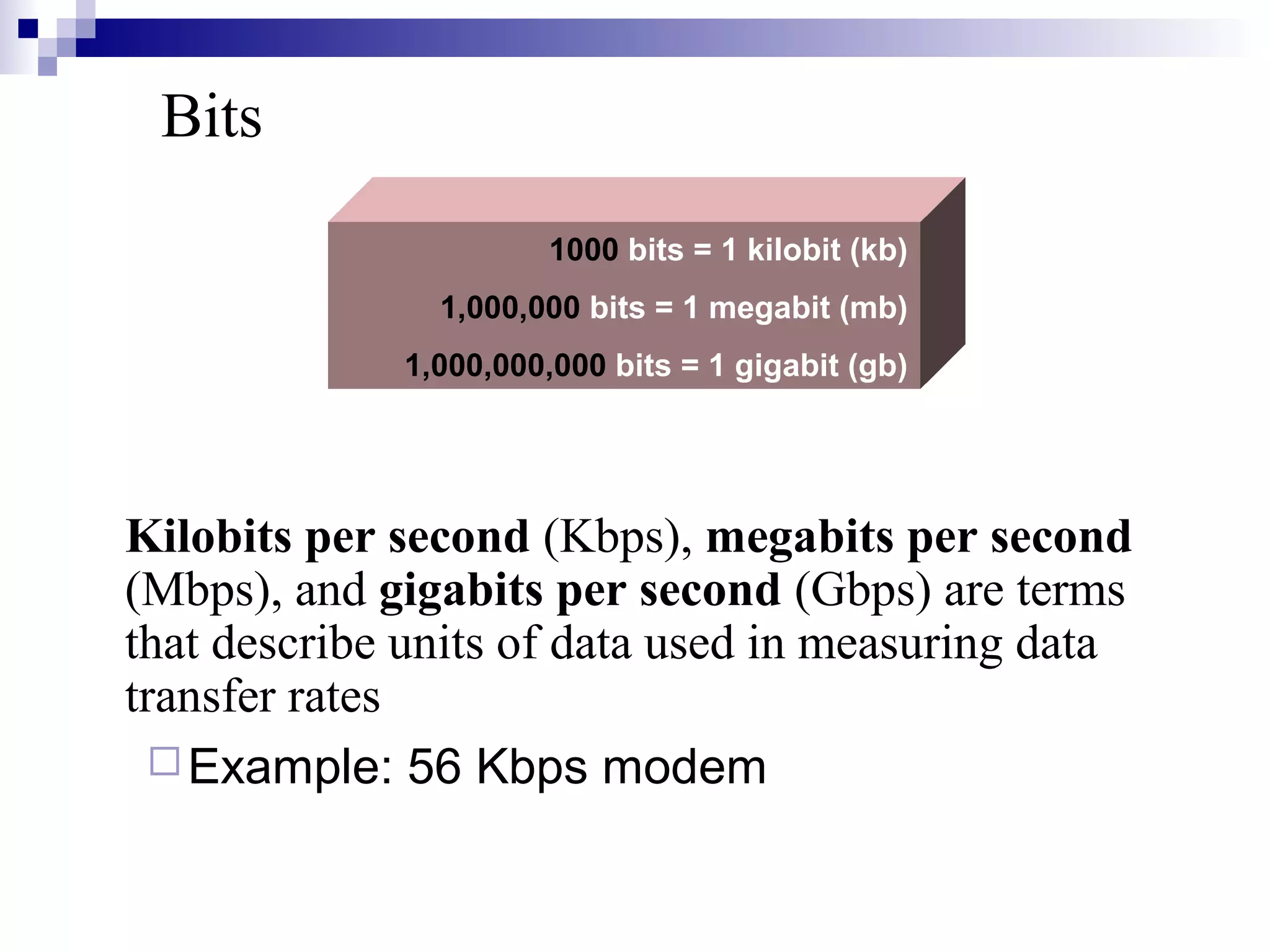
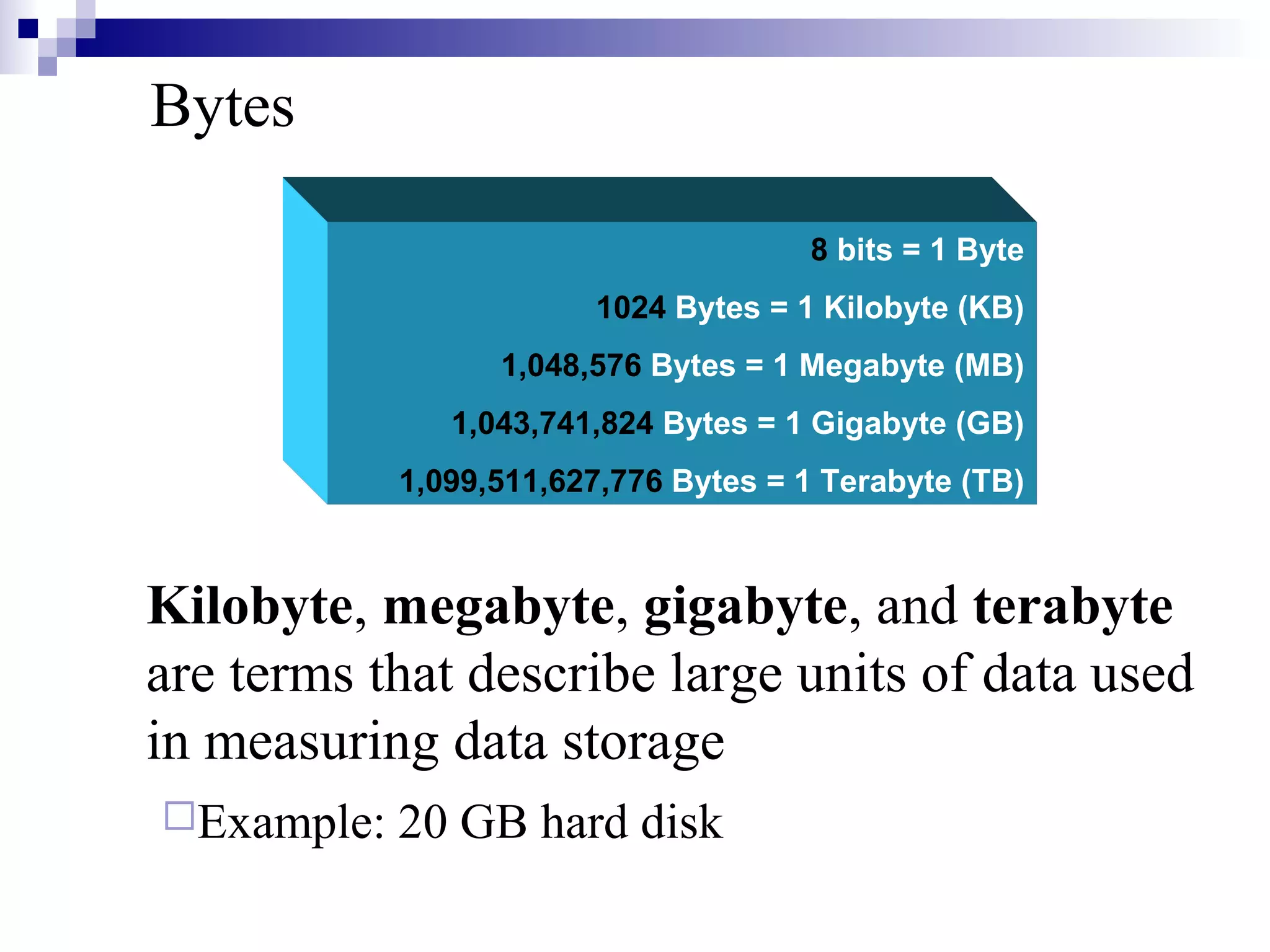
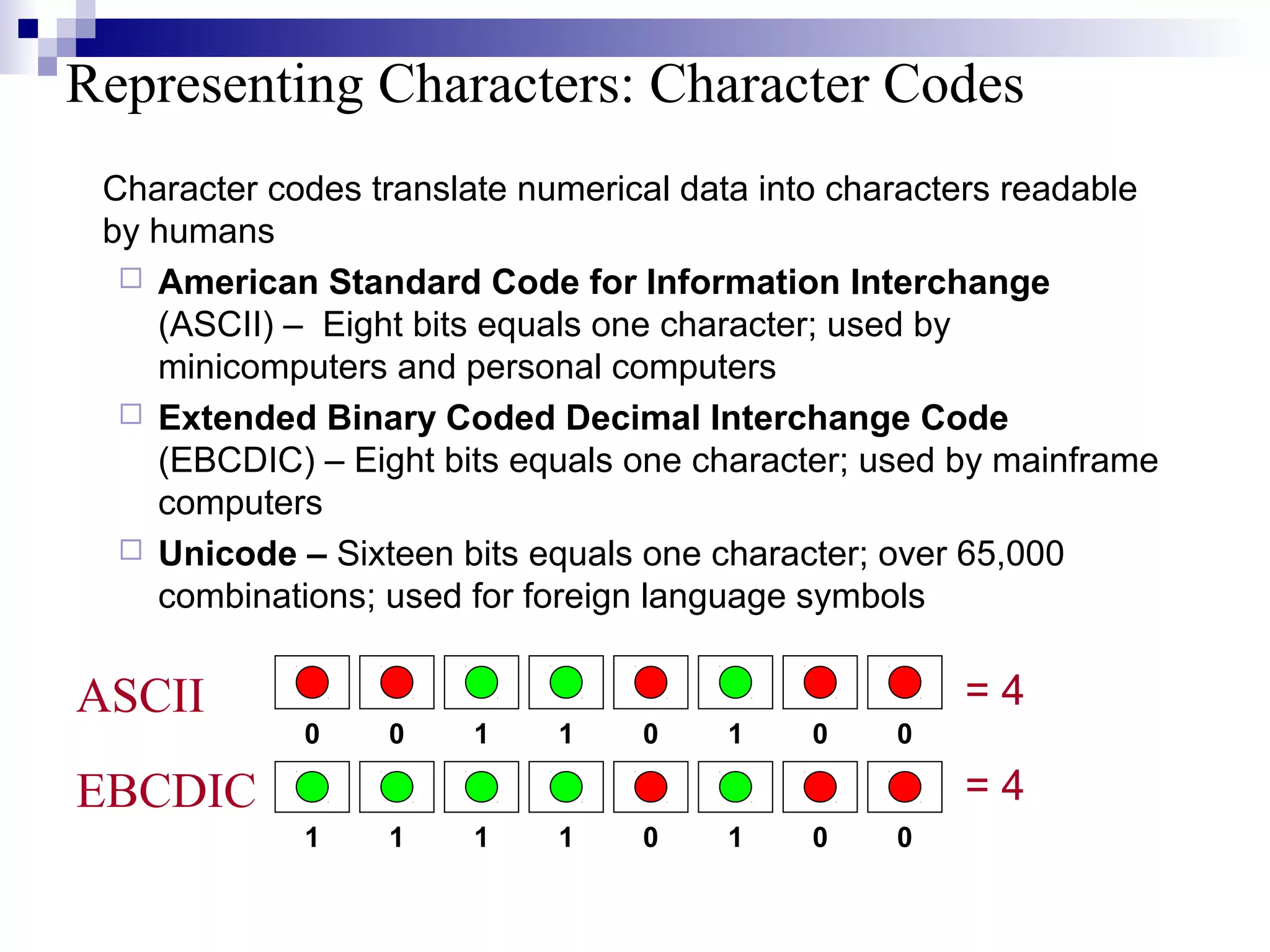
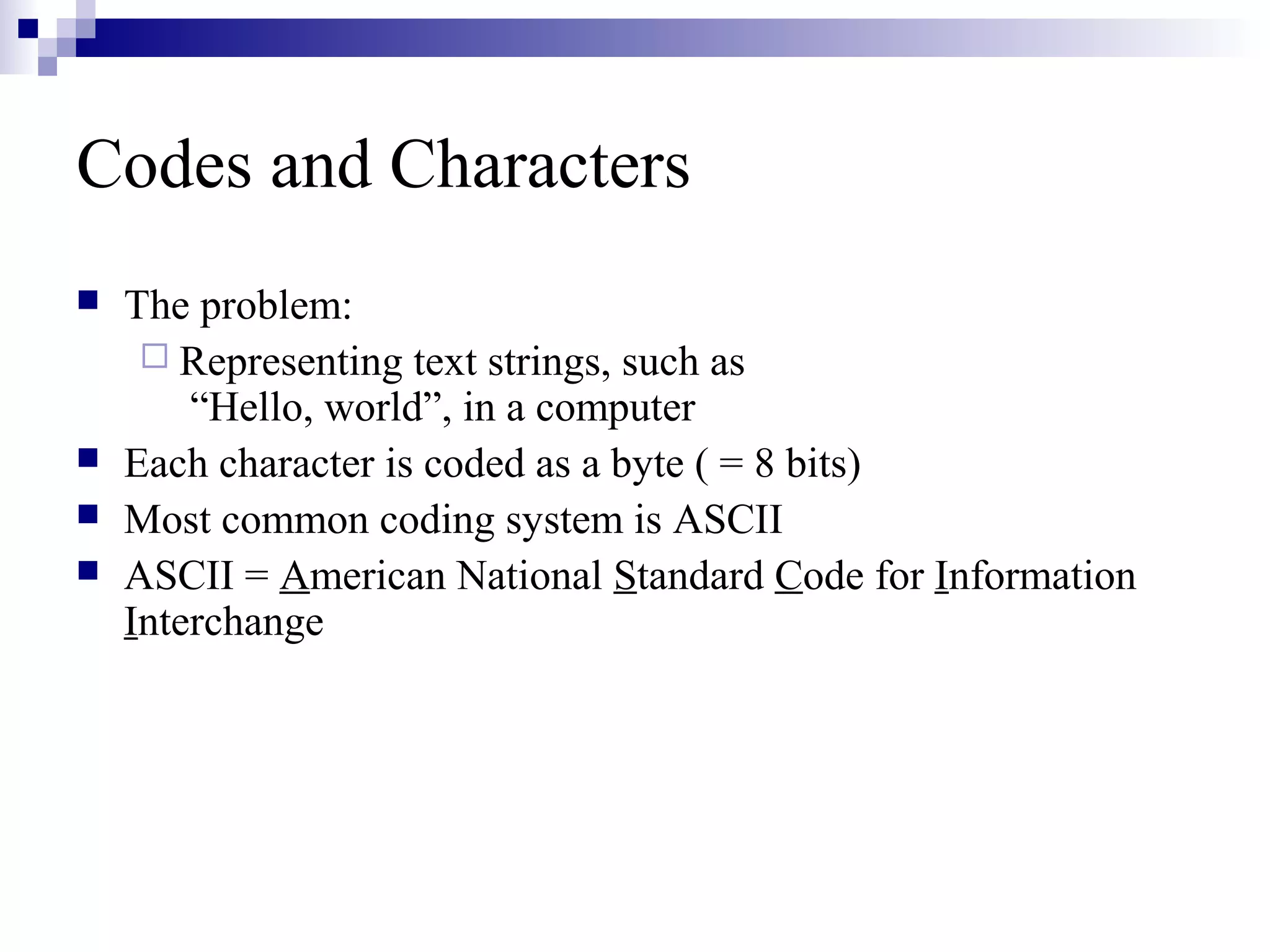
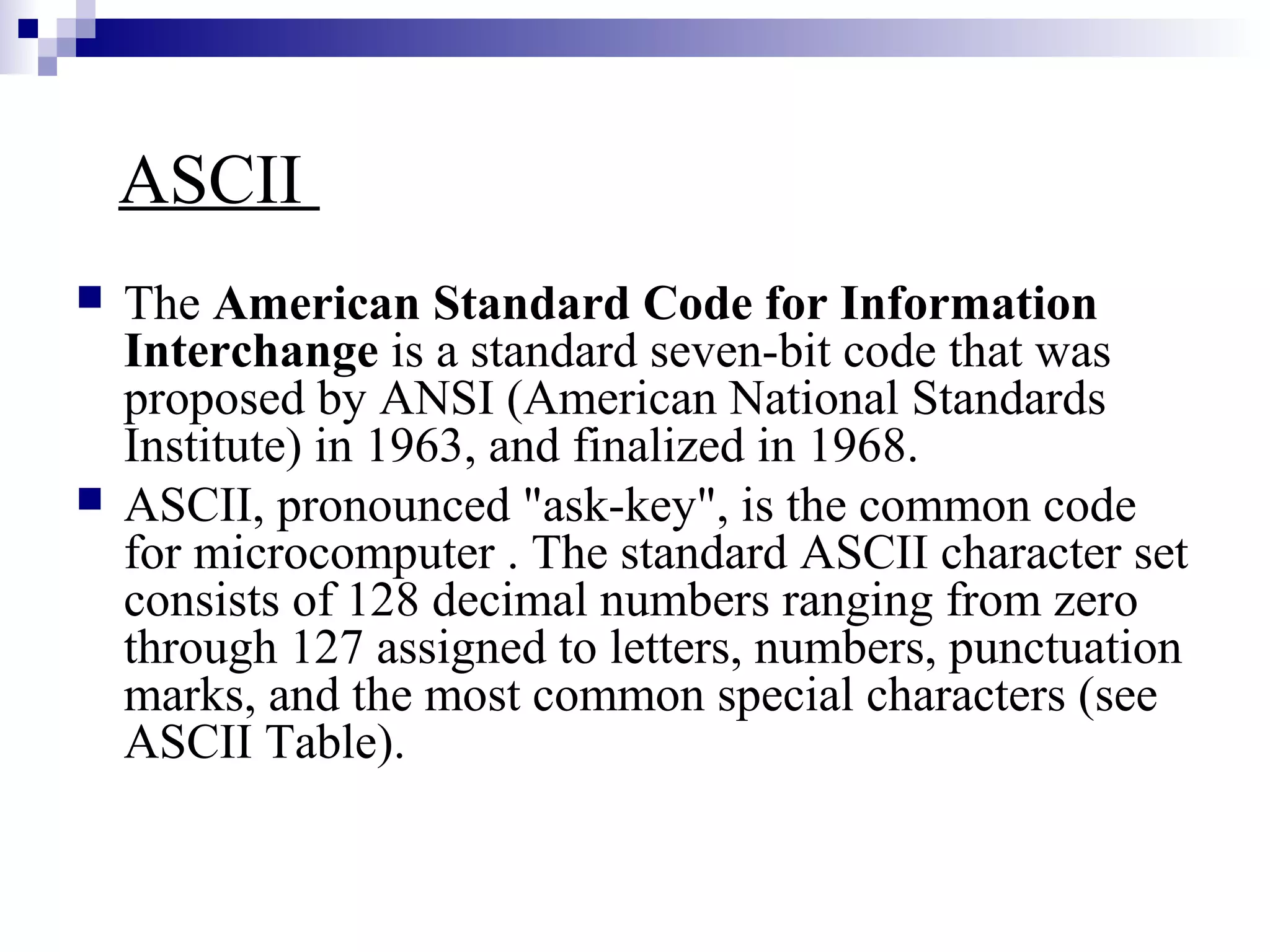
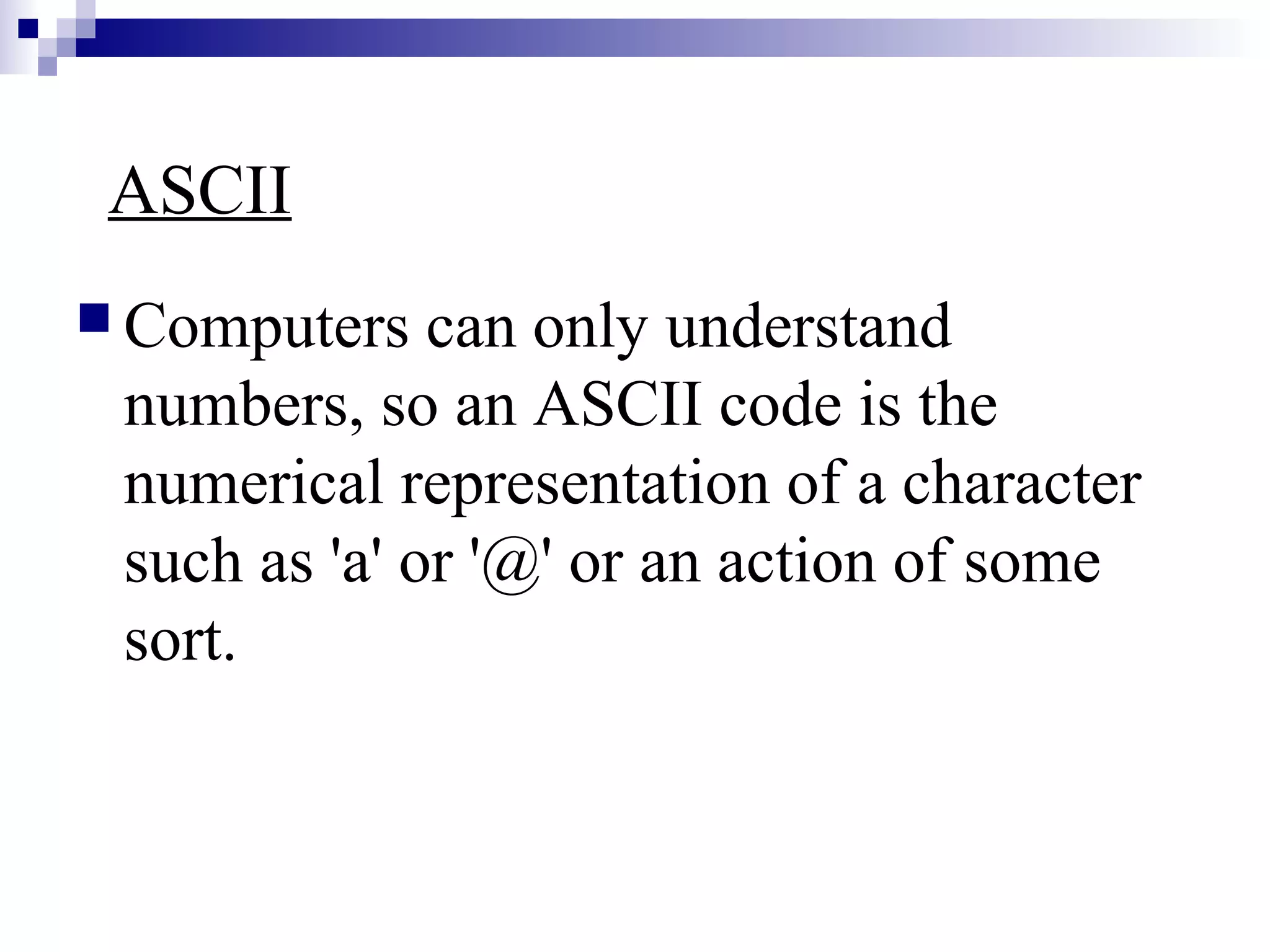
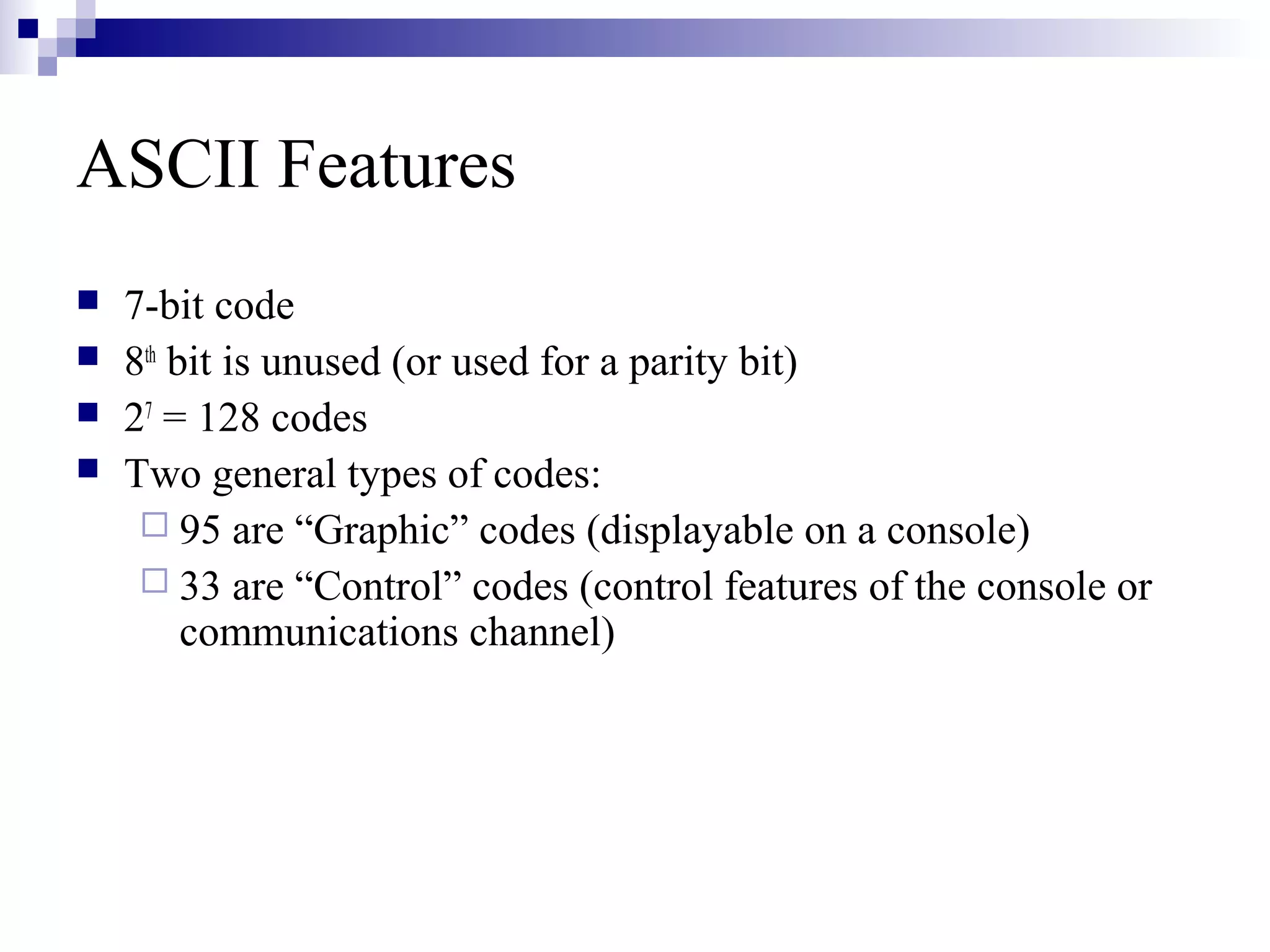
![000 001 010 011 100 101 110 111
0000 NULL DLE 0 @ P ` p
0001 SOH DC1 ! 1 A Q a q
0010 STX DC2 " 2 B R b r
0011 ETX DC3 # 3 C S c s
0100 EDT DC4 $ 4 D T d t
0101 ENQ NAK % 5 E U e u
0110 ACK SYN & 6 F V f v
0111 BEL ETB ' 7 G W g w
1000 BS CAN ( 8 H X h x
1001 HT EM ) 9 I Y i y
1010 LF SUB * : J Z j z
1011 VT ESC + ; K [ k {
1100 FF FS , < L l |
1101 CR GS - = M ] m }
1110 SO RS . > N ^ n ~
1111 SI US / ? O _ o DEL
Most significant bit
Least significant bit](https://image.slidesharecdn.com/lectureasciiandebcdiccodes-161128153257/75/Lecture-ascii-and-ebcdic-codes-10-2048.jpg)
![000 001 010 011 100 101 110 111
0000 NULL DLE 0 @ P ` p
0001 SOH DC1 ! 1 A Q a q
0010 STX DC2 " 2 B R b r
0011 ETX DC3 # 3 C S c s
0100 EDT DC4 $ 4 D T d t
0101 ENQ NAK % 5 E U e u
0110 ACK SYN & 6 F V f v
0111 BEL ETB ' 7 G W g w
1000 BS CAN ( 8 H X h x
1001 HT EM ) 9 I Y i y
1010 LF SUB * : J Z j z
1011 VT ESC + ; K [ k {
1100 FF FS , < L l |
1101 CR GS - = M ] m }
1110 SO RS . > N ^ n ~
1111 SI US / ? O _ o DEL
i.e. ‘a’ = 11000012 = 9710 = 6116](https://image.slidesharecdn.com/lectureasciiandebcdiccodes-161128153257/75/Lecture-ascii-and-ebcdic-codes-11-2048.jpg)
![95 Graphic codes
000 001 010 011 100 101 110 111
0000 NULL DLE 0 @ P ` p
0001 SOH DC1 ! 1 A Q a q
0010 STX DC2 " 2 B R b r
0011 ETX DC3 # 3 C S c s
0100 EDT DC4 $ 4 D T d t
0101 ENQ NAK % 5 E U e u
0110 ACK SYN & 6 F V f v
0111 BEL ETB ' 7 G W g w
1000 BS CAN ( 8 H X h x
1001 HT EM ) 9 I Y i y
1010 LF SUB * : J Z j z
1011 VT ESC + ; K [ k {
1100 FF FS , < L l |
1101 CR GS - = M ] m }
1110 SO RS . > N ^ n ~
1111 SI US / ? O _ o DEL](https://image.slidesharecdn.com/lectureasciiandebcdiccodes-161128153257/75/Lecture-ascii-and-ebcdic-codes-12-2048.jpg)
![33 Control codes
000 001 010 011 100 101 110 111
0000 NULL DLE 0 @ P ` p
0001 SOH DC1 ! 1 A Q a q
0010 STX DC2 " 2 B R b r
0011 ETX DC3 # 3 C S c s
0100 EDT DC4 $ 4 D T d t
0101 ENQ NAK % 5 E U e u
0110 ACK SYN & 6 F V f v
0111 BEL ETB ' 7 G W g w
1000 BS CAN ( 8 H X h x
1001 HT EM ) 9 I Y i y
1010 LF SUB * : J Z j z
1011 VT ESC + ; K [ k {
1100 FF FS , < L l |
1101 CR GS - = M ] m }
1110 SO RS . > N ^ n ~
1111 SI US / ? O _ o DEL](https://image.slidesharecdn.com/lectureasciiandebcdiccodes-161128153257/75/Lecture-ascii-and-ebcdic-codes-13-2048.jpg)
![Alphabetic codes
000 001 010 011 100 101 110 111
0000 NULL DLE 0 @ P ` p
0001 SOH DC1 ! 1 A Q a q
0010 STX DC2 " 2 B R b r
0011 ETX DC3 # 3 C S c s
0100 EDT DC4 $ 4 D T d t
0101 ENQ NAK % 5 E U e u
0110 ACK SYN & 6 F V f v
0111 BEL ETB ' 7 G W g w
1000 BS CAN ( 8 H X h x
1001 HT EM ) 9 I Y i y
1010 LF SUB * : J Z j z
1011 VT ESC + ; K [ k {
1100 FF FS , < L l |
1101 CR GS - = M ] m }
1110 SO RS . > N ^ n ~
1111 SI US / ? O _ o DEL](https://image.slidesharecdn.com/lectureasciiandebcdiccodes-161128153257/75/Lecture-ascii-and-ebcdic-codes-14-2048.jpg)
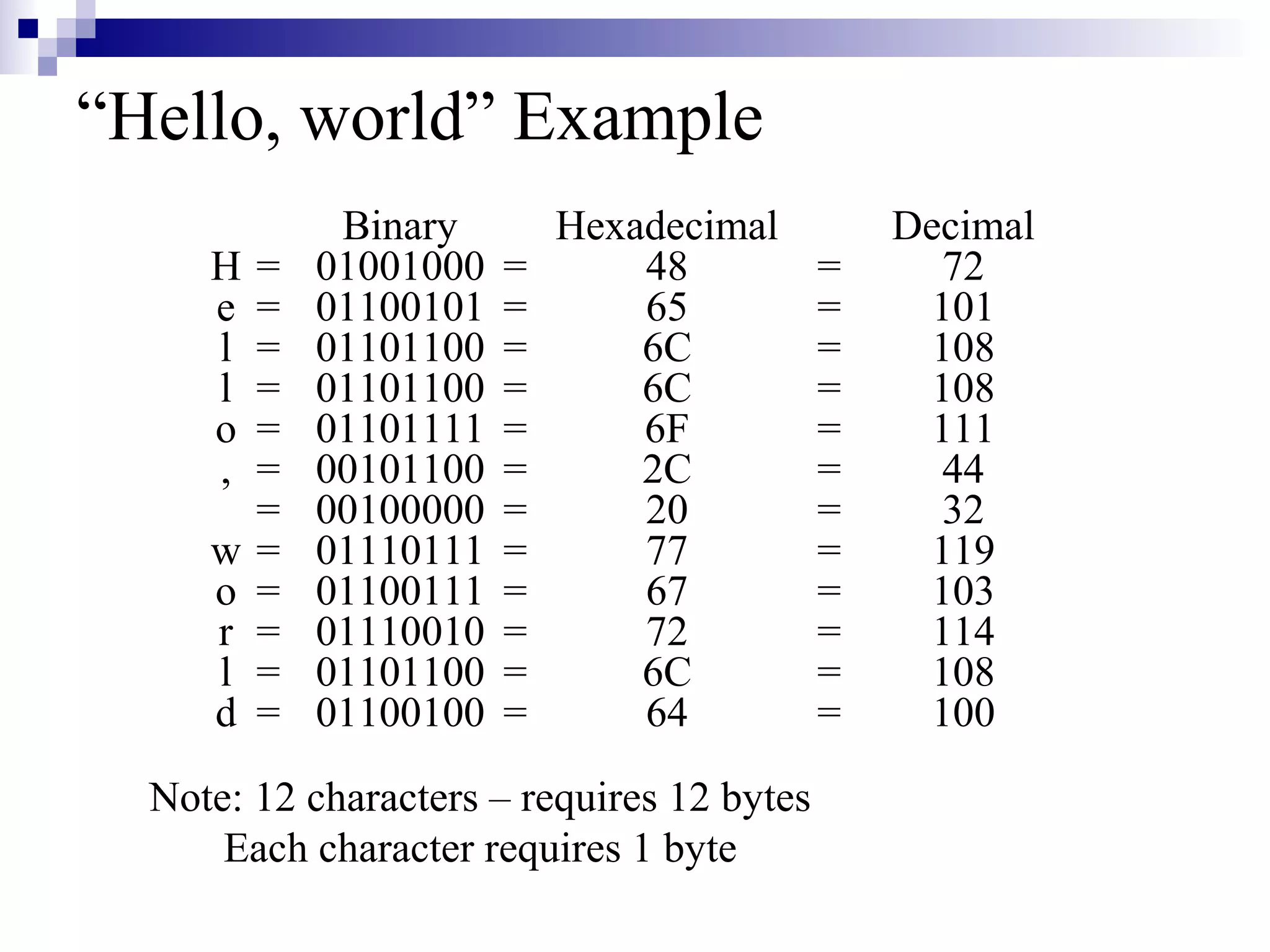
![Numeric codes
000 001 010 011 100 101 110 111
0000 NULL DLE 0 @ P ` p
0001 SOH DC1 ! 1 A Q a q
0010 STX DC2 " 2 B R b r
0011 ETX DC3 # 3 C S c s
0100 EDT DC4 $ 4 D T d t
0101 ENQ NAK % 5 E U e u
0110 ACK SYN & 6 F V f v
0111 BEL ETB ' 7 G W g w
1000 BS CAN ( 8 H X h x
1001 HT EM ) 9 I Y i y
1010 LF SUB * : J Z j z
1011 VT ESC + ; K [ k {
1100 FF FS , < L l |
1101 CR GS - = M ] m }
1110 SO RS . > N ^ n ~
1111 SI US / ? O _ o DEL](https://image.slidesharecdn.com/lectureasciiandebcdiccodes-161128153257/75/Lecture-ascii-and-ebcdic-codes-16-2048.jpg)
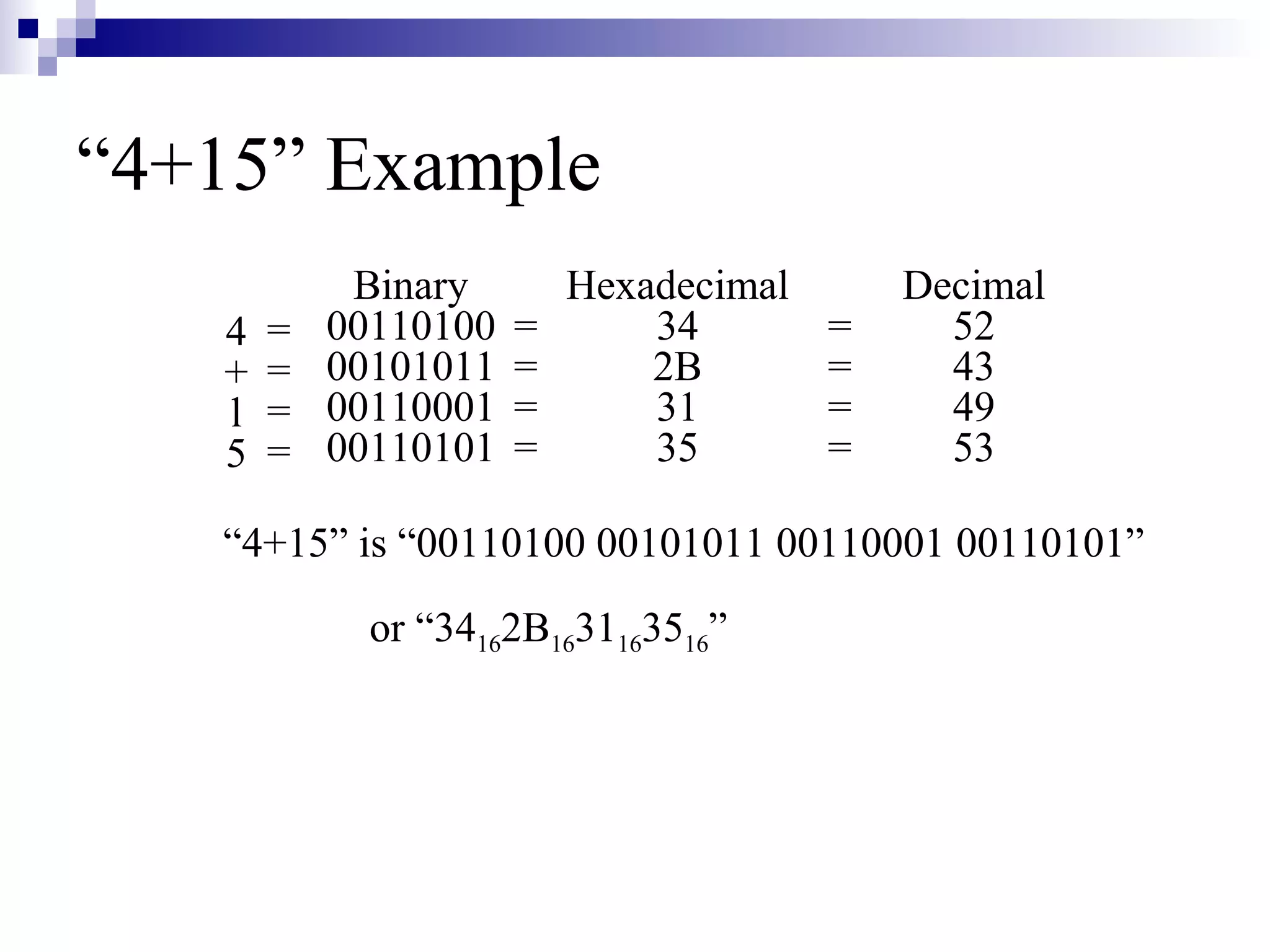
![000 001 010 011 100 101 110 111
0000 NULL DLE 0 @ P ` p
0001 SOH DC1 ! 1 A Q a q
0010 STX DC2 " 2 B R b r
0011 ETX DC3 # 3 C S c s
0100 EDT DC4 $ 4 D T d t
0101 ENQ NAK % 5 E U e u
0110 ACK SYN & 6 F V f v
0111 BEL ETB ' 7 G W g w
1000 BS CAN ( 8 H X h x
1001 HT EM ) 9 I Y i y
1010 LF SUB * : J Z j z
1011 VT ESC + ; K [ k {
1100 FF FS , < L l |
1101 CR GS - = M ] m }
1110 SO RS . > N ^ n ~
1111 SI US / ? O _ o DEL
Punctuation, etc.](https://image.slidesharecdn.com/lectureasciiandebcdiccodes-161128153257/75/Lecture-ascii-and-ebcdic-codes-18-2048.jpg)
